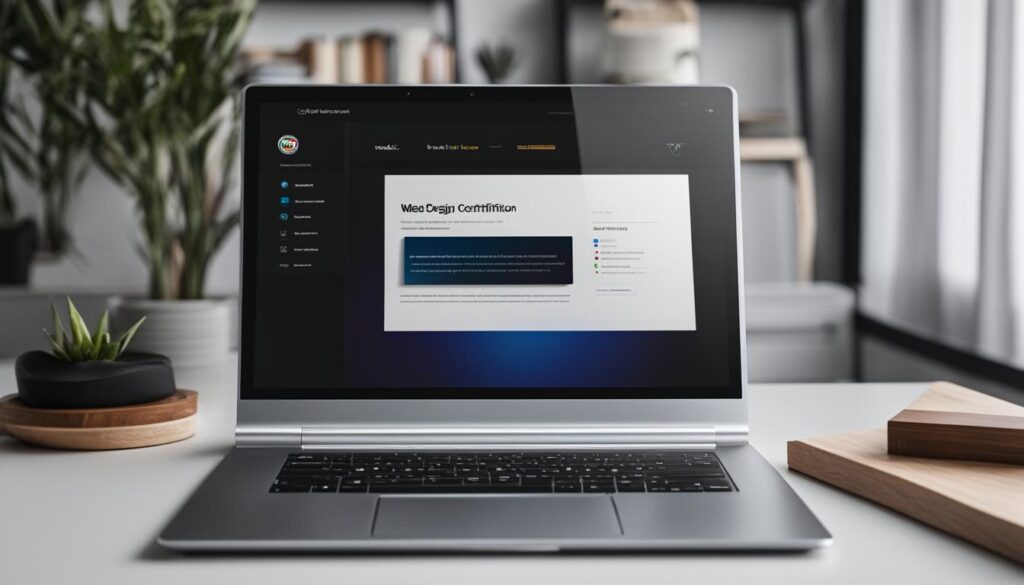Are you looking to excel in the field of web design? Our web design training online is here to help you master the skills needed to succeed. Whether you’re a beginner or want to enhance your existing knowledge, our courses cover a wide range of topics including front-end web development, HTML and CSS, JavaScript, and web development tools.
By completing our comprehensive training program, you’ll gain the necessary skills to create visually appealing and user-friendly websites. You’ll also have the opportunity to earn a web design certification, further enhancing your career prospects in the industry.
Start your web design journey today with our comprehensive web design courses that cater to all skill levels and career goals.
Choose the Best Web Design Course for Your Needs
With countless web design courses available online, it can be overwhelming to choose the best one for your needs. We have curated a list of the top 10 web design courses based on factors such as course curriculum, skill development, and industry demand. These courses cover a variety of topics including front-end web development, HTML and CSS, JavaScript, user experience design, graphic design, and more. Whether you’re a beginner or an experienced professional, you’ll find a course that suits your skill level and helps you advance in your web design career.
To assist in your decision-making process, we have provided a detailed table below comparing the top 5 web design courses based on their key features:
| Course | Curriculum | Skill Development | Industry Demand |
|---|---|---|---|
| Course 1 | HTML, CSS, JavaScript | Front-end development, UI design | High |
| Course 2 | HTML, CSS, Graphic design | Visual design, branding | Medium |
| Course 3 | HTML, CSS, JavaScript, User experience design | UX/UI design, prototyping | High |
| Course 4 | HTML, CSS, JavaScript, Responsive design | Mobile web design, cross-browser compatibility | High |
| Course 5 | HTML, CSS, JavaScript, Design principles | Design thinking, problem-solving | Medium |
By considering the curriculum, skill development opportunities, and industry demand of each course, you can make an informed decision and choose the web design course that best aligns with your goals and aspirations.
Free vs Paid Web Design Courses: Which is Right for You?
When it comes to web design courses, you have the option to choose between free and paid courses. Free courses, such as those offered by WebFlow University or freeCodeCamp, provide a great introduction to web design principles and techniques. These courses are ideal for beginners or those who want to explore web design as a hobby.
Paid courses, on the other hand, offer more comprehensive and in-depth learning experiences. They often provide hands-on projects, personalized feedback, and access to industry experts. Paid courses are recommended for individuals who are serious about a career in web design and want to gain practical skills and certifications.
When deciding between free and paid courses, consider your goals, budget, and level of commitment. Free courses are a great way to dip your toes into web design and see if it’s the right path for you. Paid courses, on the other hand, offer a more structured and guided learning experience, with the potential for more advanced skills and industry recognition.
Comparing Free and Paid Web Design Courses
| Factors | Free Courses | Paid Courses |
|---|---|---|
| Cost | Free of charge | Paid, with varying prices |
| Learning Experience | Self-paced, limited support | Structured, hands-on projects, personalized feedback |
| Course Content | Introductory, basic concepts | Comprehensive, in-depth topics |
| Industry Recognition | Less recognized, but can still showcase skills | Certifications and industry recognition |
| Support | Community forums, limited instructor support | Direct instructor support, community forums |
In conclusion, whether you choose a free or paid web design course depends on your goals, budget, and level of commitment. Free courses are a great starting point for beginners or those exploring web design as a hobby, while paid courses offer a more structured and comprehensive learning experience with industry recognition. Consider your needs and preferences, and choose the option that aligns with your goals and resources.
Top 5 Web Design Courses for Beginners
If you’re new to web design and looking to kickstart your career in this exciting field, it’s essential to find the right course that caters to your needs. Below, we’ve curated a list of the top 5 web design courses specifically tailored for beginners:
-
Web Design for Everybody: Basics of Web Development & Coding
This course, offered by the University of Michigan on Coursera, provides a comprehensive introduction to web development and coding. It covers essential topics such as HTML, CSS, and JavaScript. By the end of the course, you’ll have a solid foundation in web design principles and be able to create basic websites.
-
Ultimate Web Design Course
Created by Webflow University, this course is perfect for beginners who want to learn web design using a visual design tool. It covers topics like layout and typography, and you’ll learn how to create stunning, responsive websites without writing code.
-
W3Cx Frontend Developer Program
Designed by the World Wide Web Consortium (W3C) and offered on edX, this program focuses on front-end web development. It provides a comprehensive overview of HTML, CSS, and JavaScript, and introduces you to web design best practices.
-
Basic HTML & CSS for Non-Web Designers
This course by Don’t Fear the Internet is perfect for beginners who have no prior experience in web design. It teaches you the basics of HTML and CSS in a fun and engaging way, allowing you to create your own simple web pages.
-
Web Design for Beginners: Real World Coding in HTML & CSS
Offered on Udemy, this course takes a hands-on approach to teaching web design. You’ll learn HTML and CSS by completing real-world projects, giving you practical experience in creating visually appealing websites.
| Course | Platform | Duration | Certification |
|---|---|---|---|
| Web Design for Everybody: Basics of Web Development & Coding | Coursera | Approximately 8 months | Yes |
| Ultimate Web Design Course | Webflow University | Self-paced | No |
| W3Cx Frontend Developer Program | edX | Approximately 8 weeks | Yes |
| Basic HTML & CSS for Non-Web Designers | Don’t Fear the Internet | Self-paced | No |
| Web Design for Beginners: Real World Coding in HTML & CSS | Udemy | Approximately 6 hours | Yes |
Whether you prefer a structured university program or a self-paced online course, these options offer valuable insights and hands-on experience to help you get started in web design. Choose the course that aligns with your learning style and goals, and embark on your journey to become a skilled web designer.
Advanced Web Design Courses for Experienced Professionals
For experienced web designers who want to enhance their skills and stay updated with the latest industry trends, advanced web design courses are highly recommended. These courses delve deeper into topics such as user experience design, responsive design, JavaScript frameworks, and advanced CSS techniques. By taking these courses, you can expand your knowledge and expertise in web design and stay competitive in the job market.
The following table provides an overview of some recommended advanced web design courses:
| Course | Platform | Duration |
|---|---|---|
| Web Design Track | TreeHouse | Self-paced |
| Front End Development Nanodegree | Udacity | Approximately 4 months |
| UI Design for Developers | Design+Code | Self-paced |
These courses offer in-depth instruction, hands-on projects, and access to industry professionals, allowing you to further develop your skills and stay on top of emerging trends in the field. Whether you want to specialize in user experience design or gain expertise in front-end development, these advanced courses will help you take your web design career to the next level.
How to Choose the Right Web Design Course for You
Choosing the right web design course is crucial for your success in the field. There are several factors to consider when making this decision. Evaluate your skill level, learning style, and career goals to find a course that aligns with your needs.
Start by reviewing the course curriculum to ensure it covers the specific topics and skills you want to learn. Look for courses that offer a comprehensive range of subjects, including front-end development, HTML, CSS, JavaScript, and user experience design.
Consider the teaching methods and resources provided. Are there video lectures, hands-on projects, or interactive exercises? Find a course that offers a learning environment that suits your preferences and helps you grasp the material effectively. Additionally, check the duration and flexibility of the course to ensure it fits into your schedule.
Furthermore, if earning a certification is important to you, look for courses that offer the opportunity to obtain one. Certifications can boost your credibility among employers and clients and validate your skills and expertise.

Factors to Consider When Choosing a Web Design Course:
- Course curriculum: Ensure it covers the topics and skills you want to learn.
- Teaching methods: Look for video lectures, hands-on projects, and interactive exercises.
- Course duration and flexibility: Find a course that fits into your schedule.
- Certification opportunity: Consider if earning a certification is important to you.
| Course Name | Platform | Curriculum | Duration | Certification |
|---|---|---|---|---|
| Web Design for Everybody: Basics of Web Development & Coding | Coursera | Comprehensive | 4-6 weeks | Yes |
| Ultimate Web Design Course | Webflow University | Diverse | Self-paced | No |
| W3Cx Frontend Developer Program | edX | In-depth | 12 weeks | Yes |
| Basic HTML & CSS for Non-Web Designers | Don’t Fear the Internet | Foundational | 2 weeks | No |
| Web Design for Beginners: Real World Coding in HTML & CSS | Udemy | Practical | 2-3 hours | No |
Benefits of Web Design Training and Certification
Pursuing web design training and earning a certification can provide numerous benefits in your career. With formal training, you’ll gain a comprehensive understanding of web design principles, techniques, and technologies. This knowledge can help you create visually appealing and user-friendly websites, enhance user experience, and optimize website performance. A certification acts as proof of your expertise and can boost your credibility among employers and clients. It validates your skills and sets you apart in a competitive job market. Additionally, web design education can open doors to various job opportunities, including web designer, front-end developer, or UX/UI designer.

By undergoing web design training, you’ll learn to utilize industry-standard tools and software, allowing you to work more efficiently and effectively. These tools include graphic design software like Illustrator and Photoshop, as well as development frameworks like React. By mastering these tools, you can create innovative and visually stunning designs that meet the demands of clients and users.
Furthermore, web design training exposes you to the latest design trends, techniques, and best practices in the industry. Staying updated with the latest developments ensures that your designs remain relevant and appeal to modern audiences. It also equips you with the skills to implement responsive design, ensuring that your websites are optimized for various devices and screen sizes.
| Benefits of Web Design Training and Certification |
|---|
| Comprehensive understanding of web design principles, techniques, and technologies |
| Ability to create visually appealing and user-friendly websites |
| Enhanced user experience and optimized website performance |
| Boost in credibility among employers and clients |
| Increased job opportunities in web design and related fields |
| Exposure to industry-standard tools and software |
| Knowledge of the latest design trends and techniques |
| Ability to implement responsive design for different devices |
Overall, web design training and certification can significantly enhance your career prospects, allowing you to become a highly skilled and sought-after professional in the field. Whether you’re starting your web design journey or looking to advance your existing skills, investing in training and certification is a valuable step towards success.
Tools and Skills Every Web Designer Should Master
To excel in the field of web design, it’s essential to master certain tools and skills. As a web designer, you should be proficient in HTML and CSS, as these are the building blocks of web design. Familiarity with JavaScript and front-end web development frameworks like React can also be valuable. Additionally, graphic design software such as Illustrator and Photoshop can help you create visually appealing designs. It’s important to stay updated with the latest design trends, user experience principles, and responsive design techniques. By continually honing your skills and staying up to date with industry tools and trends, you can deliver high-quality and engaging web designs.
Essential Tools for Web Designers
- HTML: The markup language used to structure web pages.
- CSS: The style sheet language used to style the appearance of web pages.
- JavaScript: A programming language that adds interactivity to web pages.
- React: A JavaScript library for building user interfaces.
- Illustrator: A graphic design software for creating vector graphics.
- Photoshop: A graphic design software for editing and manipulating images.
- Responsive Design: The practice of designing websites that adapt to different screen sizes.
Mastering Skills for Web Designers
- HTML and CSS: Learn how to structure and style web pages using these fundamental languages.
- JavaScript: Gain proficiency in JavaScript to add interactivity and dynamic elements to your designs.
- User Experience Design: Understand the principles of UX design to create intuitive and user-friendly websites.
- Responsive Design: Learn how to design websites that look and function optimally on different devices.
- Graphic Design: Hone your skills in graphic design to create visually appealing and aesthetically pleasing designs.
- UI Design: Develop expertise in creating intuitive and visually engaging user interfaces.
- Front-End Web Development: Familiarize yourself with front-end development frameworks and tools to enhance your design capabilities.
| Tool/Skill | Description |
|---|---|
| HTML | The markup language used to structure web pages. |
| CSS | The style sheet language used to style the appearance of web pages. |
| JavaScript | A programming language that adds interactivity to web pages. |
| React | A JavaScript library for building user interfaces. |
| Illustrator | A graphic design software for creating vector graphics. |
| Photoshop | A graphic design software for editing and manipulating images. |
| Responsive Design | The practice of designing websites that adapt to different screen sizes. |
To become a proficient web designer, it is crucial to master these essential tools and skills. By combining technical expertise with design principles, you can create visually appealing and user-friendly websites that leave a lasting impression. Stay updated with the latest trends, continuously learn and improve your skills, and experiment with new tools to stay ahead in the dynamic world of web design.
Conclusion
Web design training plays a crucial role in equipping individuals with the necessary skills to excel in the dynamic field of web design. Whether you opt for a free or paid course, it is imperative to choose one that aligns with your skill level, learning style, and career aspirations. Investing in web design education allows you to expand your knowledge, acquire practical skills, and earn valuable certifications that enhance your credibility in the industry.
By undertaking web design training, you can gain a comprehensive understanding of web design principles, techniques, and technologies. These insights enable you to create visually appealing and user-friendly websites while optimizing user experience and website performance. Additionally, a certification serves as a testament to your expertise, setting you apart from others in the competitive job market and opening doors to various opportunities, such as web designer, front-end developer, or UX/UI designer.
Mastering essential tools and skills is essential for every web designer aiming to excel in the field. From HTML and CSS, which form the foundation of web design, to JavaScript and front-end web development frameworks, staying up-to-date with industry trends and design principles is vital. Continuous improvement and staying informed about the latest tools and techniques allow you to deliver high-quality and engaging web designs, leading to success in this fast-growing field.



